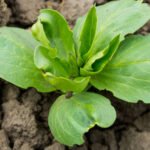Winter doesn’t have to be a time of hibernation for your garden. With cold frame winter vegetable gardening, you can extend your growing season and continue to enjoy fresh, vibrant vegetables even in the coldest months. In this article, we will delve into the benefits of winter vegetable gardening in a cold frame, exploring how this technique allows you to nurture and harvest nutritious crops throughout the winter season.
Using a cold frame is a clever way to create a microclimate that protects your plants from harsh weather conditions while harnessing the power of natural light and warmth. By using this technique, you can unlock a world of possibilities for growing vegetables beyond the traditional spring and summer seasons.
From crunchy lettuces and tender root vegetables to hearty leafy greens and herbs bursting with flavor, there is an exciting array of vegetables waiting to be cultivated in your very own cold frame.
Imagine being able to walk outside during the peak of winter and pluck fresh, organic produce straight from your garden. In addition to providing you with an abundant supply of nutritious vegetables, cold frame gardening also offers numerous environmental benefits. It reduces food mileage by allowing you to grow your own produce year-round and decreases pollution associated with transporting fruits and vegetables over long distances.
So whether you are an experienced gardener looking to expand your knowledge or a novice eager to embark on a new adventure, join us as we enter into the enchanting world of cold frame winter vegetable gardening. Unlocking the secrets of growing robust crops during frosty days will not only ignite your passion for gardening but also lead you down a path towards healthier eating habits and greater self-sufficiency in any season.
Getting Started
Choosing the Right Type of Cold Frame
Before you start winter vegetable gardening in a cold frame, it is important to choose the right type of cold frame that suits your needs and preferences. There are several options available, each with its own advantages and disadvantages.
One option is a traditional wooden cold frame, which provides excellent insulation and durability. These frames are usually made from rot-resistant materials like cedar or redwood. Another option is a plastic or polycarbonate cold frame, which is lightweight, affordable, and offers good insulation. However, it may not be as durable as a wooden frame.
Assembling and Preparing Your Cold Frame
Once you have chosen the type of cold frame that works best for you, it’s time to assemble and prepare it for winter vegetable gardening. Start by selecting a suitable location for your cold frame. It should receive maximum sunlight during the day and be sheltered from strong winds.
Next, prepare the site by leveling the ground and removing any debris or weeds. If necessary, create a foundation for your cold frame using bricks or cinder blocks to ensure stability. Assemble the components of your cold frame according to the manufacturer’s instructions.
Considerations for Optimal Growth and Protection
To ensure optimal growth and protection for your winter vegetables, there are some key considerations to keep in mind when setting up your cold frame. Good ventilation is essential to prevent overheating on sunny days and condensation buildup that can lead to fungal diseases.
Consider installing adjustable vents or propping open one side of the lid during warmer days. Additionally, insulate your cold frame by adding straw bales around the perimeter or using row covers inside the frame.
Lastly, consider adding a layer of mulch inside your cold frame to help retain moisture in the soil and provide extra insulation for your plants.
By carefully selecting the right type of cold frame, assembling it properly, and taking into account important considerations for growth and protection, you will be well on your way to successful winter vegetable gardening. The next step is to choose the right winter vegetables that will thrive in your cold frame during the colder months.
Selecting the Right Winter Vegetables for Your Cold Frame
When it comes to selecting the right winter vegetables for your cold frame, it’s important to choose varieties that thrive in colder temperatures and shorter daylight hours. Fortunately, there are many cold-hardy vegetables that can be successfully grown in a cold frame during winter. Here are some top choices to consider:
- Leafy Greens: Leafy greens like kale, spinach, and Swiss chard are excellent options for winter gardening. They can tolerate freezing temperatures and continue growing slowly throughout the season. These nutrient-packed greens can be harvested as needed for fresh salads or cooked dishes.
- Root Vegetables: Root vegetables such as carrots, turnips, and beets are well-suited for cold frames. They have a natural ability to withstand colder weather and maintain their flavor even in chilly conditions. By planting these root crops in your cold frame, you’ll have a supply of delicious and nutritious ingredients throughout the winter.
- Brassicas: Brassicas like broccoli, cauliflower, and Brussels sprouts are sturdy plants that can handle the cold. In fact, some varieties of Brussels sprouts taste even better after being exposed to frost. These vegetables offer a wide range of culinary possibilities and can be enjoyed steamed, roasted, or added to hearty winter soups.
- Alliums: Alliums include onions, leeks, garlic, and shallots – all of which can thrive in a cold frame during winter. These aromatic bulbs provide a burst of flavor to various dishes and add diversity to your garden’s harvest list.
- Herbs: While not technically vegetables, many herbs are hardy enough to withstand winter conditions in a cold frame. Rosemary, thyme, sage, and oregano are particularly resilient herbs that can continue providing fresh flavors year-round.
By choosing these winter vegetables for your cold frame garden, you’ll ensure a fruitful harvest even in the coldest months of the year.
Cultivating a Variety of Winter Vegetables
To make the most of your cold frame, consider cultivating a variety of winter vegetables. This not only provides you with a diverse range of flavors and textures, but it also helps maintain soil health and prevent the buildup of pests and diseases. Additionally, growing different types of vegetables in your cold frame can maximize the use of space and ensure a continuous supply throughout the season.
When selecting from each vegetable category mentioned above, choose a mix of early and late-maturing varieties. This way, you’ll have a staggered harvest schedule, allowing you to enjoy fresh produce over an extended period. For example, select both short-season kale that matures quickly for early harvests and long-season kale for continuous harvesting later in winter.
Furthermore, consider planting companion plants that benefit each other when grown together. Some beneficial pairings include planting onions alongside carrots to deter carrot flies or interplanting radishes and lettuce to utilize vertical space efficiently.
Overall, by selecting a diverse range of winter vegetables for your cold frame garden and incorporating companion planting strategies, you’ll create a thriving ecosystem that promotes healthy plant growth and enhances your overall gardening experience.
Adapting Vegetable Selection to Regional Climates
It’s important to note that the suitability of specific winter vegetables may vary depending on your regional climate. While certain vegetables thrive in colder regions with consistent snow cover, others perform better in milder climates with occasional frost. Research local climate data or consult with experienced gardeners in your area to determine which winter vegetables are best suited for your specific location.
Additionally, consider the microclimate within your garden itself. Assess where your cold frame is positioned in relation to surrounding structures or natural features like trees or walls. These elements can provide some protection against frost or wind exposure and create favorable conditions for certain vegetables.
Remember that experimenting with different varieties and adjusting your vegetable selection year by year is part of the joy of gardening. Adaptability is key, and with some trial and error, you will discover which winter vegetables thrive best in your cold frame garden.
Preparing the Soil and Planting in Your Cold Frame
When it comes to ensuring the success of your winter vegetable garden in a cold frame, preparing the soil is crucial. By providing your plants with nutrient-rich and well-drained soil, you can create an optimal growing environment that promotes healthy growth and development throughout the winter months. Here are some key steps to follow when preparing the soil in your cold frame:
- Soil Preparation: Before planting your winter vegetables, it’s essential to prepare the soil by removing any weeds or debris. This will help prevent competition for nutrients and ensure that your plants have ample space to grow. Loosen the soil gently using a garden fork or trowel, being careful not to disturb the structure too much.
- Adding Organic Matter: Enhancing your soil with organic matter can greatly improve its fertility and moisture-retaining capacity. Consider incorporating compost, well-rotted manure, or leaf mold into the top few inches of soil within your cold frame. These organic materials provide essential nutrients for plant growth and help retain moisture during periods of low rainfall or irrigation.
- Adjusting pH Levels: Testing and adjusting the pH levels of your soil can also contribute to successful plant growth. Most winter vegetables prefer slightly acidic to neutral soils with a pH range of 6.0-7.Use a pH testing kit available at garden centers or online stores to determine your soil’s acidity level. If necessary, raise or lower the pH by adding lime (to increase alkalinity) or sulfur (to increase acidity) accordingly.
Once you have prepared the soil in your cold frame, it’s time to start planting. Whether you choose to sow seeds directly or transplant seedlings from indoor starts, it is important to follow proper spacing and depth guidelines for each vegetable you intend to grow.
- Sowing Seeds: When sowing seeds in a cold frame, ensure that each seed is planted at the appropriate depth for optimal germination and growth. This information can usually be found on the seed packet or in gardening references. Additionally, be mindful of the recommended spacing between each seed, allowing adequate room for plants to develop and access light and nutrients.
- Transplanting Seedlings: If you prefer to start your winter vegetables indoors before moving them into the cold frame, it’s crucial to “harden off” your seedlings gradually. This involves gradually exposing them to outdoor conditions over a period of 7-10 days before transplanting. When planting seedlings in your cold frame, ensure that they are placed at the correct spacing to prevent overcrowding and promote proper air circulation.
Remember to water your newly planted seeds or transplants gently but thoroughly, ensuring that the soil remains consistently moist but not waterlogged. Regularly monitor your plants’ progress throughout the winter season, making adjustments to watering practices as necessary based on weather conditions and plant needs.
By diligently preparing the soil and properly planting your winter vegetables in a cold frame, you are setting yourself up for a successful and bountiful harvest. So roll up your sleeves, get your hands dirty, and enjoy the process of growing vibrant vegetables during the snowy months.
Cold Frame Maintenance during Winter
Maintaining a healthy cold frame during winter requires special attention to watering, ventilation, and temperature control. Proper care of your cold frame will ensure the optimal growth and protection of your winter vegetables.
Watering is a critical aspect of maintaining a cold frame during the winter months. While it’s important to keep the soil moist, overwatering can lead to waterlogged soil and root rot.
To avoid this, it’s best to water your cold frame in the morning so that any excess moisture has a chance to evaporate throughout the day. It’s also advisable to use room temperature or tepid water when watering your plants, as very cold water can send them into shock.
Ventilation is another key factor in maintaining a healthy cold frame. Good airflow helps prevent mold and disease from developing due to excessive humidity. On sunny days, open up the lid of your cold frame to allow fresh air to circulate around your plants. However, be cautious not to leave it open for too long if there is a risk of freezing temperatures at night.
Temperature control is vital for protecting your winter vegetables from extreme weather conditions. During sunny but cold days, the temperature inside your cold frame can rise significantly. To regulate the temperature, you can prop open the lid slightly or remove it completely for some time. On extremely cold nights, consider covering your cold frame with insulating materials such as blankets or straw.
To summarize, proper maintenance of your cold frame during winter involves careful watering practices to avoid overwatering and waterlogged soil. Good ventilation is necessary to prevent excess humidity and promote airflow around your plants. Finally, strategic temperature control measures will protect your winter vegetables from extreme weather conditions.
| Aspect | Recommendations |
|---|---|
| Watering | – Water in the morning to allow excess moisture to evaporate throughout the day
|
| Ventilation | – Open the lid of your cold frame on sunny days for fresh air circulation
|
| Temperature Control | – Prop open or remove the lid on sunny but cold days to regulate temperature
|
Protecting Your Winter Vegetables from Pests and Diseases in the Cold Frame
While winter vegetable gardening in a cold frame offers many advantages, it also presents unique challenges when it comes to pest and disease management. As the temperatures drop, certain pests become more dormant, but others thrive in the sheltered environment of a cold frame. Additionally, diseases can easily spread in the colder and moister conditions. However, with proper knowledge and preventive measures, you can protect your winter vegetables and ensure a healthy harvest.
One common pest that gardeners may encounter in their cold frames during winter is aphids. These tiny insects can quickly multiply and damage your plants by sucking out their sap. To prevent an infestation, regularly inspect your plants for any signs of aphids. If you spot them early on, remove them manually or use a strong stream of water to dislodge them from your plants. Alternatively, consider introducing beneficial insects such as ladybugs or lacewings that feed on aphids.
Another pesky critter that can wreak havoc on your winter vegetables is slugs. These slimy creatures are particularly active in cool and damp conditions. To deter slugs from infiltrating your cold frame, create barriers such as copper tape or abrasive surfaces like diatomaceous earth around the perimeter of your frame. You can also set up beer traps by burying a shallow dish filled with beer at ground level to attract and drown slugs.
In addition to pests, fungal diseases pose a threat to winter vegetables grown in a cold frame due to the higher humidity levels inside the structure. One effective way to prevent fungal diseases is by providing good airflow within the cold frame to reduce moisture buildup. Regularly open vents or raise one side of the lid slightly during warmer days to allow fresh air circulation. Also, try spacing out your plants adequately to promote air circulation around them.
To maintain good garden hygiene and mitigate disease spread, remove any debris or fallen leaves from your cold frame regularly. Avoid overcrowding plants, as this can create a humid and cramped environment that favors disease development. If you notice any signs of disease, such as discoloration, spots, or wilting, promptly remove the affected plants to prevent further contamination.
By following these precautions and being vigilant in monitoring your winter vegetables, you can successfully protect them from pests and diseases throughout the winter season. Implementing organic solutions and preventive measures will contribute to maintaining a healthy cold frame and ensure a bountiful harvest of fresh and vibrant winter vegetables.
Harvesting and Enjoying Fresh Winter Vegetables from Your Cold Frame
Section Five: Harvesting and Enjoying Fresh Winter Vegetables from Your Cold Frame
Harvesting the fresh winter vegetables from your cold frame is an exciting and rewarding part of cold frame gardening. Not only do you get to enjoy the fruits of your labor, but you also have access to nutritious and flavorful produce during the colder months. Here are some tips to help you make the most of your harvest:
- Harvesting Timing: Each winter vegetable has its own ideal harvesting time, so it’s essential to familiarize yourself with the specific requirements of each plant. For example, root vegetables like carrots and beets can be harvested as soon as they reach a desirable size, while others like kale and Brussels sprouts taste even better after being exposed to frost for enhanced sweetness.
- Harvesting Techniques: To harvest your winter vegetables, use a sharp knife or shears to carefully cut away mature leaves or stalks without damaging the plant. For root vegetables, gently loosen the soil around them before pulling from the ground. Be sure to handle delicate crops such as lettuce with care to avoid bruising or wilting.
- Celebrating Winter Flavors: Winter vegetables have their unique flavors that shine when combined with complementary ingredients. Roasting root vegetables with olive oil and herbs brings out their natural sweetness and creates a warm side dish for any meal. Soups and stews become heartier by adding nutrient-packed leafy greens like kale or Swiss chard. Experiment with various cooking methods to showcase the delicious flavors of your harvested winter produce.
By following these guidelines, you can maximize the freshness and taste in every bite of your winter vegetable harvest. Remember that one advantage of cold frame gardening is that you can enjoy homegrown produce well into winter when traditional outdoor gardens are dormant.
Inspiring Recipes and Meal Ideas
To inspire you in incorporating your winter vegetables into tasty meals, here are a few recipe ideas:
- Roasted Root Vegetable Medley: Toss together a variety of root vegetables such as carrots, beets, parsnips, and turnips with olive oil, garlic, and your favorite herbs. Roast them in the oven until golden and tender for a delightful side dish.
- Winter Kale Salad: Combine freshly harvested kale with thinly sliced Brussels sprouts, pomegranate seeds, toasted almonds, and a zesty citrus vinaigrette. This vibrant salad is packed with nutrients and bursts of flavor.
- Savory Winter Stew: Create a comforting stew by combining winter vegetables like potatoes, leeks, celery root, and winter squash with vegetable or chicken broth. Add cooked beans or lentils for protein and season with herbs like rosemary or thyme.
These recipes are just starting points – feel free to customize them based on the specific winter vegetables you have harvested from your cold frame. The possibilities for creating delicious winter meals are endless.
With the ongoing fulfillment of harvesting fresh produce from your cold frame during the colder months of the year comes great satisfaction. Embrace the joy of eating locally grown food all year round while nourishing your body with nutrient-dense vegetables cultivated right at home.
Cold Frame Winter Vegetable Gardening Success Stories and Inspiring Examples
As you embark on your journey into cold frame winter vegetable gardening, it is beneficial to draw inspiration from others who have experienced great success in this practice. These stories serve as a reminder that with the right knowledge and dedication, a bountiful winter harvest is well within reach.
One inspiring example comes from Sarah, a passionate gardener who turned her cold frame into a thriving oasis during the coldest months of the year. With careful planning and attention to detail, she was able to grow a variety of vegetables such as kale, spinach, and carrots all through winter. Sarah’s story serves as an encouragement for beginners in cold frame gardening that even with limited space and resources, remarkable results can be achieved.
Another success story comes from a community project where neighbors came together to create a shared cold frame garden. For these individuals, winter gardening became more than just about reaping the rewards of fresh produce. It became an opportunity for community building, bonding over shared experiences, and exchanging recipes made with their flavorful winter vegetables. This example highlights how cold frame winter vegetable gardening has the potential to foster connections and strengthen ties within communities.
These success stories exemplify how successful cold frame winter vegetable gardens are not limited to professional gardeners or those with extensive experience. Anyone with the desire to embrace this rewarding practice can achieve remarkable results. By learning from the experiences of others and adapting their techniques to fit your own circumstances, you too can join the thriving community of cold frame winter vegetable gardeners.
So why not take advantage of this magical method? Explore the benefits highlighted earlier in this article and discover the joy of growing vibrant and nutritious vegetables during even the harshest winters. As you embark on your own journey into cold frame winter vegetable gardening, know that you are not alone – there is a community waiting to welcome you and share in your successes along the way.
Frequently Asked Questions
What vegetables can you grow in winter cold frame?
Winter cold frames are a great way to extend the growing season and continue growing vegetables throughout the colder months. There are several vegetables that can be successfully grown in a winter cold frame. One popular option is leafy greens such as spinach, kale, and lettuce, which are hardy and can tolerate cooler temperatures.
Other options include root vegetables like carrots, radishes, and turnips, as well as herbs like parsley and cilantro. These vegetables can thrive in the protected environment provided by a cold frame, where they are sheltered from frost and extreme cold.
Can cold frames be used in the winter?
Yes, cold frames can certainly be used in the winter season. In fact, that is one of their main purposes – to create a microclimate that protects plants from freezing temperatures and extends the growing season into colder months. Cold frames work by trapping heat from sunlight during the day, creating a warm and sheltered environment for plants inside.
The clear covering allows sunlight to enter while preventing heat from escaping at night. This insulation helps keep plants inside the cold frame warmer than outside temperatures, making it possible to grow certain crops even in winter.
What can I overwinter in a cold frame?
A cold frame offers an ideal environment for overwintering various plants and extending their lifespan through the colder months. Many cool-season crops can be overwintered in a cold frame to provide fresh produce even when outdoor conditions would otherwise render them dormant or non-productive. Perennial herbs like rosemary, thyme, sage, mint, and oregano can often survive well in a cold frame during winter if properly protected.
Additionally, some biennial vegetables such as onions or leeks may be kept growing or held in a dormant state until spring within a well-insulated cold frame. Depending on your region’s climate and how extreme the winter conditions get, you may also consider overwintering potted plants like strawberries or certain flowers using a cold frame for extra protection against frost damage.

If you’re looking to get into vegetable gardening, or are just looking for some tips on how to make your current garden better, then you’ve come to the right place! My name is Ethel and I have been gardening for years. In this blog, I’m going to share with you some of my best tips on how to create a successful vegetable garden.





